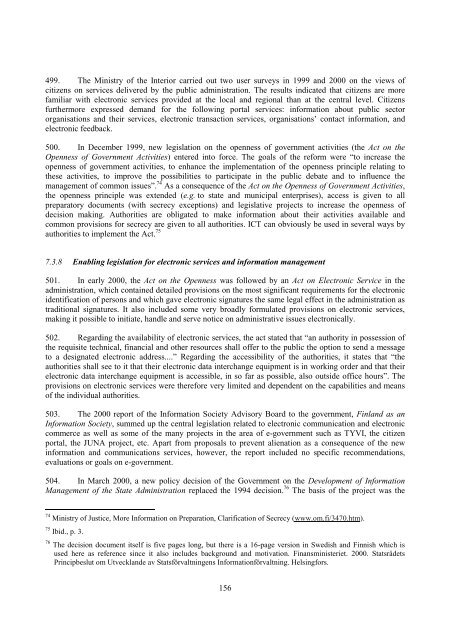e-GOVERNMENT IN FINLAND - ePractice.eu
e-GOVERNMENT IN FINLAND - ePractice.eu
e-GOVERNMENT IN FINLAND - ePractice.eu
Create successful ePaper yourself
Turn your PDF publications into a flip-book with our unique Google optimized e-Paper software.
499. The Ministry of the Interior carried out two user surveys in 1999 and 2000 on the views of<br />
citizens on services delivered by the public administration. The results indicated that citizens are more<br />
familiar with electronic services provided at the local and regional than at the central level. Citizens<br />
furthermore expressed demand for the following portal services: information about public sector<br />
organisations and their services, electronic transaction services, organisations’ contact information, and<br />
electronic feedback.<br />
500. In December 1999, new legislation on the openness of government activities (the Act on the<br />
Openness of Government Activities) entered into force. The goals of the reform were “to increase the<br />
openness of government activities, to enhance the implementation of the openness principle relating to<br />
these activities, to improve the possibilities to participate in the public debate and to influence the<br />
management of common issues”. 74 As a consequence of the Act on the Openness of Government Activities,<br />
the openness principle was extended (e.g. to state and municipal enterprises), access is given to all<br />
preparatory documents (with secrecy exceptions) and legislative projects to increase the openness of<br />
decision making. Authorities are obligated to make information about their activities available and<br />
common provisions for secrecy are given to all authorities. ICT can obviously be used in several ways by<br />
authorities to implement the Act. 75<br />
7.3.8 Enabling legislation for electronic services and information management<br />
501. In early 2000, the Act on the Openness was followed by an Act on Electronic Service in the<br />
administration, which contained detailed provisions on the most significant requirements for the electronic<br />
identification of persons and which gave electronic signatures the same legal effect in the administration as<br />
traditional signatures. It also included some very broadly formulated provisions on electronic services,<br />
making it possible to initiate, handle and serve notice on administrative issues electronically.<br />
502. Regarding the availability of electronic services, the act stated that “an authority in possession of<br />
the requisite technical, financial and other resources shall offer to the public the option to send a message<br />
to a designated electronic address....” Regarding the accessibility of the authorities, it states that “the<br />
authorities shall see to it that their electronic data interchange equipment is in working order and that their<br />
electronic data interchange equipment is accessible, in so far as possible, also outside office hours”. The<br />
provisions on electronic services were therefore very limited and dependent on the capabilities and means<br />
of the individual authorities.<br />
503. The 2000 report of the Information Society Advisory Board to the government, Finland as an<br />
Information Society, summed up the central legislation related to electronic communication and electronic<br />
commerce as well as some of the many projects in the area of e-government such as TYVI, the citizen<br />
portal, the JUNA project, etc. Apart from proposals to prevent alienation as a consequence of the new<br />
information and communications services, however, the report included no specific recommendations,<br />
evaluations or goals on e-government.<br />
504. In March 2000, a new policy decision of the Government on the Development of Information<br />
Management of the State Administration replaced the 1994 decision. 76 The basis of the project was the<br />
74 Ministry of Justice, More Information on Preparation, Clarification of Secrecy (www.om.fi/3470.htm).<br />
75 Ibid., p. 3.<br />
76 The decision document itself is five pages long, but there is a 16-page version in Swedish and Finnish which is<br />
used here as reference since it also includes background and motivation. Finansministeriet. 2000. Statsrådets<br />
Principbeslut om Utvecklande av Statsförvaltningens Informationförvaltning. Helsingfors.<br />
156
















